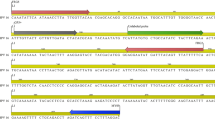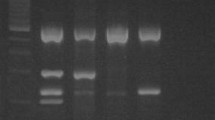Abstract
A modified non-radioactive single strand conformation polymorphism analysis incorporating a temperature gradient (TG-SSCP) and temperature gradient gel electrophoresis (TGGE) were evaluated for the detection of human papillomavirus type 6 (HPV 6)-variants in 41 condylomata acuminata and 5 Buschke-Loewenstein tumours. TG-SSCP and TGGE analysed part of the transforming ORF E6 of HPV 6 spanning nucleotides 10 to 495. TG-SSCP distinguished between 8 HPV 6-variants whereas TGGE demonstrated 6 different DNA-species. HPV 6-strains found in Buschke-Loewenstein tumours did not vary in the analysed portion of the E6 ORF as compared to ordinary condylomata acuminata. TG-SSCP and TGGE further showed absence of double infection with different HPV 6-strains in the analysed samples. Our results demonstrated that both methods may be successfully used for the detection of different strains of microbiological agents, although TG-SSCP seemed to provide easier execution and to confer a higher degree of flexibility than TGGE.
Similar content being viewed by others
References
Gissmann L, zur Hausen H. Partial characterization of viral DNA from human genital warts(Condylomata acuminata). Int J Cancer 1980; 25: 605–609.
Gissmann L, de Villiers E-M, zur Hausen H. Analysis of human genital warts(Condylomata acuminata) and other genital tumors for human papillomavirus type 6 DNA. Int J Cancer 1982; 29: 143–146.
Gissmann L, Wolnik L, Ikenberg H, et al. Human papillomavirus types 6 and 11 DNA sequences in genital and laryngeal papillomas and in some cervical cancers. Proc Natl Acad Sci USA 1983; 80: 560–563.
Rübben A, Beaudenon S, Favre M, et al. Rearrangements of the upstream regulatory region of human papillomavirus type 6 can be found in both Buschke-Löwenstein tumours and inCondylomata acuminata. J Gen Virol 1992; 73: 3147–3153.
Becker TM, Stone KM, Alexander ER. Genitalhuman papillomavirus infection: A growing concern. Obstet Gynecol Clin North Am 1987; 14: 389–396.
Chuang TY, Perry HO, Kurland LT, Ilstrup DM.Condyloma acuminatum in Rochester, Minn., 1950–1978. Parts I and II. Arch Dermatol 1984; 120: 469–483.
Orita M, Suzuki Y, Sekiya T, Hayashi R. Rapid and sensitive detection of point mutations and DNA polymorphisms using the polymerase chain reaction. Genomics 1989; 5: 874–879.
Xi LF, Demers W, Kiviat NB, et al. Sequence variation in the noncoding region of human papillomavirus type 16 detected by single-strand conformation polymorphism analysis. J Infect Dis 1993; 168: 610–617.
Ke SH, Kelly PJ, Wartell RM, et al. Selecting DNA fragments for mutation detection by temperature gradient gel electrophoresis: Application to the p53 gene cDNA. Electrophoresis 1993; 14: 561–565.
Riesner D, Steger G, Zimmat R, et al. Temperature-gradient gel electrophoresis of nucleic acids: Analysis of conformational transitions, sequence variations, and protein-nucleic acids interactions. Electrophoresis 1989; 10: 377–389.
Rosenbaum V, Riesner D. Temperature-gradient gel electrophoresis: Thermodynamic analysis of nucleic acids and proteins in purified form and in cellular extracts. Biophys Chem 1987; 26: 235–246.
Schwarz E, Dürst M, Demankowski C, et al. DNA sequence and genome organization of genital human papillomavirus type 6b. EMBO J 1983; 2: 2341–2348.
Saiki R, Scharf S, Faloona F, et al. Enzymatic amplification of β-globulin genomic sequences and restriction site analysis for diagnosis of sickle cell anemia. Science 1985; 230: 1350–1354.
Poland D. Recursion related generation of probability profiles for specific-sequence macromolecules with large-range correlations. Biopolymers 1974; 13: 1859–1871.
Beckmann AM, Sherman KJ, Myerson D, et al. Comparative virologic studies ofCondylomata acuminata reveal a lack of dual infections with human papillomaviruses. J Infect Dis 1991; 163: 393–396.
Author information
Authors and Affiliations
Corresponding author
Rights and permissions
About this article
Cite this article
Rübben, A., Traidl, C., Baron, J.M. et al. Evaluation of non-radioactive temperature gradient SSCP analysis and of temperature gradient gel electrophoresis for the detection of HPV 6-variants in condylomata acuminata and Buschke-Loewenstein tumours. Eur J Epidemiol 11, 501–506 (1995). https://doi.org/10.1007/BF01719300
Accepted:
Issue Date:
DOI: https://doi.org/10.1007/BF01719300




